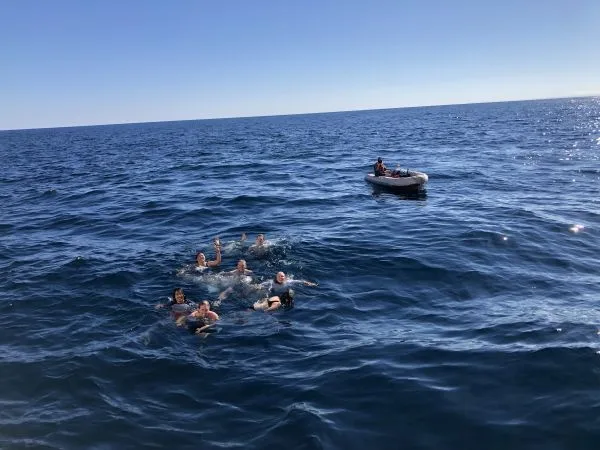Programs Blog
The Last Blog Post

Author: Kelsey Lane, Chief Scientist
https://sea.edu/wp-content/uploads/2022/01/P1050884.gif
The final days of S-299 were a whirlwind. In the wee hours of July 5, the students successfully completed their mission; all watches worked together and accomplished navigating to and completing a neuston net tow at three CalCOFI sampling stations. The next few hours we headed towards the harbor entrance, striking sails as we went. We entered San Diego harbor in the dawn light. All of the twinkling lights and busy traffic were quite an adjustment after so long in our little bubble, far offshore. We bunkered fuel, then headed to an anchorage not far from our pier. We had one more day of being together, not quite back in the bustling real world. The students tackled bunk love, cleaning the small space they’ve lived in for six weeks. We had our final field day, with a rousing pump up by C Watch. Then everyone laid into some harbor furling of the main, squares’ls, and heads’ls. The ship felt clean and loved when we were done, ready for more adventures.
Cookie prepared ribs, smoked haloumi, fried rice and a big salad for our final dinner. How we have salad on our final night of a 40 day program is beyond me, but I’ve been so impressed by the quality of the food and the fresh veggies that have carried us through this long passage. That evening, we gathered on the quarterdeck for the S-299 Swizzle. Our Swizzle Committee and MCs – Christina, Emily and Sophia – decorated the quarterdeck with glitter, lights and banners. We toasted Neptune, King of the Ocean, for our safe passage, as well as Cap for his excellent leadership. The toasts continued until we’d toasted everyone onboard, drinking our orange-ginger swizzle drink down to the bottom of the glass. Then, the performances began. Each watch had their own act to share – C watch did a rap roast of each other, B watch reenacted our epic fin whale encounter, and A watch rewrote ‘Father Abraham’ to lyrics for Captain Rick. We had music, poems, trivia, stories, and paper plate awards scattered throughout the evening and even some fireworks in the background, perfectly illuminating our small gathering. We pretended like they were marking the end of our program, like all of San Diego knew of our successful voyage.
The next morning, July 6, we came alongside the Maritime Museum of San Diego dock early, around 6:00. After tying up, putting on chafe gear, settling the boat, and students packing their last bags, we gathered for our final meeting. I recounted our oceanographic accomplishments – 71 neuston tows, 2342 ml of zooplankton biomass measured,7560 pieces of plastic hand picked, 26,000-ish meter hydrowire sent into the ocean, 670 sea birds observed and 30+ marine mammals to dazzle us. Cap reminded everyone to stay curious and compassionate. We all crammed onto the headrig for a S-299 photo, cramming in close and mask-free one more time as we prepared to enter a world with Covid still looming large. The opportunity to feel normal again for six weeks, stand close to people and bump shoulders while sweating a line and hug friends, has been a true blessing. The teary hugs and goodbyes lasted the next hour as students trickled away to the airport or family pick-ups. Eventually, it was just the staff left, sad and relieved and tired, moving around an eerily quiet ship.
S-299 was a resounding success! We sailed 4500nm into the middle of the North Pacific Gyre, sampling many of the interesting and variable regions of this ocean from the California Current to the subtropical ‘desert-like’ North Pacific Subtropical Gyre to the North Pacific Transition Zone. We sailed much more than we motored and the students grew as sailors, scientists and leaders to the point that we could truly hand the ship over to them to run in the last 24 hour mission. The clouds were a rare companion the whole trip, but at least very few of us had sunburns to show from the hours and hours outside!
These long passages are tiring, but so fulfilling. We truly see the potential and power of the classic SEA program with six weeks focused on the ship. Goodbye, but just for now, S-299 shipmates! I’ll never forget our time together.
– Kelsey Lane, Chief Scientist
Contact: Douglas Karlson, Director of Communications, 508-444-1918 | [email protected]
Recent Posts from the Ships
- Ocean Classroom 2024-A collaborative high school program with Proctor Academy
- Collaborations and Long-term Commitments: SEA’s Caribbean Reef Program Sets a Course for Coastal Programs that Compliment Shipboard Experiences.
- Sea Education Association students prepare for life underway using state of the art nautical simulation from Wartsila Corporation.
- SEA Writer 2022, Magazines From the Summer SEA Quest Students
- Technology@SEA: Upgrades Allow Insight into Ocean Depths
Programs
- Gap Year
- Ocean Exploration
- High School
- Science at SEA
- SEA Expedition
- SEAScape
- Pre-College
- Proctor Ocean Classroom
- Protecting the Phoenix Islands
- SPICE
- Stanford@SEA
- Undergraduate
- Climate and Society
- Climate Change and Coastal Resilience
- Coral Reef Conservation
- Marine Biodiversity and Conservation
- MBL
- Ocean Exploration: Plastics
- Ocean Policy: Marine Protected Areas
- Oceans and Climate
- Pacific Reef Expedition
- The Global Ocean: Hawai'i
- The Global Ocean: New Zealand